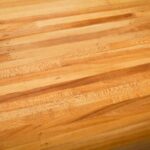When it comes to woodworking, the choice of wood can greatly impact the final result of a project. One wood that has been gaining attention in the woodworking industry is apple wood. Renowned for its versatility and unique characteristics, apple wood offers a range of possibilities for craftsmen and artisans alike.
In this article, we will delve into the origins of apple wood, exploring its history and availability in the woodworking industry. We will also examine the natural aesthetics and color variations that make apple wood stand out among other types of wood. Additionally, we will evaluate its strength and durability, essential factors when considering a medium for woodworking applications.
Working with apple wood introduces a set of challenges and considerations that require specialized knowledge and techniques. We will provide tips on how to work with this distinctive material effectively while also highlighting any potential obstacles that may be encountered along the way. From functional to stylish applications, we will showcase innovative uses of apple wood in furniture and cabinetry design.
Furthermore, preserving and maintaining apple wood to ensure longevity and beauty in woodworking projects is crucial. We will discuss key strategies to nurture and protect this unique wood species so it can maintain its charm over time. Additionally, we will examine the sustainability and ecological benefits associated with using apple wood in woodworking projects.
For those looking to expand their woodworking arsenal or seeking inspiration for new project ideas, incorporating apple wood into their creations offers endless possibilities. We explore how apple wood can complement or enhance other wood selections in unique projects, showcasing its versatility as part of various aesthetic compositions.
Finally, through case studies of successful projects utilizing apple wwood, we aim to provide readers with aesthetic inspirations and project ideas that demonstrate the allure of working with this extraordinary material. With its versatility, beautiful natural characteristics, and sustainable aspects, there is no doubt that apple wood has become a favored option among experienced craftsmen as well as aspiring artisans delving into the world of woodworking.
Understanding the Origins
Apple wood has a long-standing history in the woodworking industry, with its origins dating back centuries. In this section, we will delve into the rich history of apple wood and explore its availability in the woodworking industry today.
History of Apple Wood
Apple wood has been used for various purposes throughout history, ranging from tool handles to furniture and cabinetry. Ancient civilizations recognized its durability and unique properties, making it a popular choice for crafting functional and decorative items. The use of apple wood can be traced back to Egyptian tombs, where furniture made from this versatile wood was discovered.
In Europe, apple trees have been cultivated for centuries to produce fruits. As a result, there is an abundant supply of apple wood available in regions where apple orchards are prevalent. The tradition of utilizing apple wood in woodworking continues to this day in countries like England and France, where artisans value its natural beauty and workability.
Availability of Apple Wood
In recent years, there has been a growing demand for specialty woods in the woodworking industry. This trend has led to increased availability of apple wood as more suppliers recognize its unique qualities. While not as widely available as some other types of hardwoods, apple wood can be obtained from specialty lumber yards or directly from orchards that prune their trees regularly.
It is important to note that the availability of apple wood may vary depending on your geographic location. For instance, areas with a thriving apple industry are more likely to have a steady supply of this type of wood. Additionally, sustainability practices should be considered when sourcing apple wood to ensure that it is harvested responsibly and without causing harm to the environment or disrupting necessary agricultural practices.
As interest in working with unique and sustainable woods grows, it is likely that availability and accessibility of apple wood will continue to increase within the woodworking industry.
The Beauty in Apple Wood
Apple wood is known for its beautiful natural aesthetics and unique color variations, making it a popular choice among woodworkers for various projects. When working with apple wood, one can expect to discover a plethora of visual delights that add character and charm to their creations.
One of the most notable features of apple wood is its stunning grain patterns. The grain in apple wood can range from straight and uniform to irregular and wavy, offering endless possibilities for creative designs. The distinctive grain pattern adds depth and texture to woodworking projects, creating visually striking pieces that stand out.
In addition to its grain patterns, apple wood also exhibits a wide range of color variations. From reddish-brown tones to light honey hues, each piece of apple wood carries its own unique blend of colors. These natural variations allow woodworkers to create pieces with rich and dynamic visual appeal.
To make the most out of the natural beauty of apple wood, it is often recommended to apply a clear finish rather than staining it. This allows the true colors and patterns of the wood to shine through, showcasing the organic beauty that makes apple wood so special.
When incorporating apple wood into woodworking projects, it is important to carefully select the right pieces with desirable aesthetics and characteristics. Considerations such as color variation, grain pattern, and overall quality should be taken into account when choosing apple wood for a project.
Overall, the beauty in apple wood lies in its natural aesthetics and color variations. Woodworkers can unleash their creativity by utilizing these unique qualities in their designs, resulting in visually stunning and one-of-a-kind pieces that truly showcase the allure of this versatile material.
Strength and Durability
Apple wood may not be the first type of wood that comes to mind when thinking about strength and durability, but it is actually quite impressive in these areas. When evaluating the structural integrity and longevity of apple wood in woodworking applications, it becomes clear that this wood has a lot to offer.
One of the key factors that contribute to the strength of apple wood is its density. Apple wood has a high density, which makes it sturdy and resistant to warping or cracking. This makes it particularly suitable for furniture and cabinetry projects where durability is important.
In addition to its density, apple wood also possesses natural oils and resins that further enhance its strength and durability. These oils and resins act as a protective barrier against pests, decay, and moisture damage. As a result, apple wood can withstand the test of time, making it an excellent choice for long-lasting woodworking projects.
| Wood Type | Modulus of Rupture (psi) | Janka Hardness (lbf) |
|---|---|---|
| Apple Wood | 14,000-15,000 | 1,800 |
| Oak | 14,000-16,000 | 1,290-1,360 |
| Maple | 9,500-12,500 | 950-1,450 |
Looking at these numbers, we can see that apple wood compares favorably to both oak and maple, two of the most popular hardwoods in woodworking. Its modulus of rupture (a measure of maximum stress a material can withstand before breaking) is similar to oak, while its Janka hardness (a measure of wood’s resistance to denting and wear) is higher than both oak and maple.
With its impressive strength and longevity, apple wood proves that it is not only a beautiful choice for woodworking projects but also a reliable and durable one. Woodworkers can confidently work with apple wood knowing that their creations will stand the test of time.
Working with Apple Wood
Apple wood is known for its unique characteristics and versatility in woodworking projects. Whether you are a beginner or an experienced woodworker, working with apple wood can present some tips, techniques, and challenges that are worth exploring. Here are some key considerations to keep in mind when using apple wood as a medium:
- Selecting and sourcing apple wood: When choosing apple wood for your project, it is important to select high-quality pieces that are free from defects such as knots, cracks, or decay. Look for well-dried and seasoned apple wood to ensure stability and minimize the risk of warping or splitting during the woodworking process.
Apple wood can be found at specialty lumberyards, orchards, or even through local arborists who may have recently pruned or removed apple trees. - Preparing the wood: Before starting any woodworking project with apple wood, it is crucial to properly prepare the wood for optimal results. This includes removing the bark and any remaining branches or twigs. Additionally, rough-sawing the material into usable dimensions will make it easier to work with during shaping and joinery processes.
- Working techniques: Apple wood has a fine texture and is generally easy to work with hand tools or power tools. However, it can be prone to tear-out due to interlocking grain patterns, especially when planing or routing against the grain direction. To minimize tear-out, it is recommended to use sharp tools and take light cuts. It is also advisable to experiment with grain direction and cutting angles to achieve the best possible results.
- Finishing considerations: Apple wood features a beautiful natural color range from pale yellowish-brown to reddish-brown hues which darken over time when exposed to sunlight. To enhance its natural beauty, many woodworkers prefer using transparent finishes such as oils or varnishes instead of opaque paints that could obscure the grain pattern.
Before applying any finish, ensure that your apple wood project has been sanded to a smooth surface and any dust or debris has been removed.
While working with apple wood can be enjoyable, it is essential to address the challenges that may arise. The interlocking grain, mentioned earlier, can present some difficulties during shaping and joinery processes. Additionally, the inherent hardness of apple wood may require using specialized cutting tools or techniques to prevent excessive wear on cutting edges. By understanding these challenges and employing appropriate techniques, woodworkers can harness the unique aesthetics and characteristics of apple wood to create stunning woodworking projects.
Functional and Stylish
Apple wood is not only prized for its unique aesthetics, but it also offers versatility and durability that make it an excellent choice for furniture and cabinetry design. In this section, we will explore some innovative uses of apple wood in these applications.
Furniture Design
Apple wood can be incorporated into various furniture designs to create stunning and functional pieces. Its warm tones and beautiful grain patterns add a touch of natural elegance to any room. One popular use of apple wood in furniture design is in the production of tables.
The rich color variations and striking grain patterns make apple wood tables true statement pieces. Additionally, apple wood can be used to create chairs, bed frames, cabinets, and shelving units, among other furniture items. Its strength and durability ensure that the finished products will withstand the test of time.
Cabinetry Design
Apple wood is also highly sought after for cabinetry design due to its aesthetic appeal and durability. Cabinets made from apple wood bring a sense of warmth and sophistication to kitchens, bathrooms, living rooms, or any other space where storage is needed. Apple wood cabinets can be designed with intricate details such as carved motifs or decorative edges to enhance their visual appeal. This type of cabinetry adds a touch of elegance to any interior while providing functional storage solutions.
Combining Apple Wood with Other Materials
Designers often use a combination of materials to create unique and visually appealing pieces. Apple wood can complement or enhance other materials such as glass, metal, or stone in furniture and cabinetry design.
For example, incorporating glass into an apple wood coffee table can showcase the natural beauty of the wood while adding a modern touch. Similarly, combining apple wood with metal accents in cabinet handles or door frames can create an interesting contrast between organic warmth and sleek industrial style.
Preservation and Maintenance
Apple wood, with its unique characteristics and natural beauty, requires proper preservation and maintenance to ensure its longevity and enhance the beauty of woodworking projects. This section will explore various techniques and practices that woodworkers can employ to nurture and protect apple wood.
One crucial aspect of preserving apple wood is proper drying. Apple wood has a high moisture content when freshly cut, making it prone to warping, cracking, and decay if not dried correctly. Woodworkers should aim for a moisture content of around 6-8% before using apple wood in their projects.
This can be achieved by air drying the wood or using kiln drying methods. It is important to note that air drying may take several months, whereas kiln drying can significantly reduce the drying time.
To protect apple wood from moisture damage and decay, it is essential to apply a suitable finish. A finish acts as a protective barrier against water penetration while enhancing the natural grain and color of the wood. Tung oil or Danish oil are popular choices among woodworkers for finishing apple wood due to their ability to penetrate the surface deeply and provide excellent protection.
Regular maintenance is also crucial for preserving the beauty of apple wood over time. Woodworkers should regularly inspect their projects for any signs of wear or damage, such as scratches or dents. These can be addressed by sanding the affected area lightly and reapplying a fresh coat of finish.
| Preservation Techniques | Maintenance Practices |
|---|---|
| Proper drying techniques (air drying or kiln drying) | Regular inspection for wear or damage |
| Applying a suitable finish (tung oil or Danish oil) | Sanding and reapplying finish as needed |
By employing these preservation techniques and implementing regular maintenance practices, woodworkers can ensure the longevity and beauty of apple wood in their woodworking projects. From furniture to cabinetry, apple wood will continue to be a stunning choice for crafting timeless pieces that showcase its versatility and natural charm.
Environmental Considerations
Apple wood is not only prized for its unique aesthetic qualities and structural integrity, but it also offers several environmental benefits that make it a sustainable choice for woodworking projects. Understanding the sustainability and ecological benefits of working with apple wood can help woodworkers make informed decisions about their material choices.
One of the greatest environmental benefits of apple wood is its abundance. Apple trees are widely cultivated around the world for their fruit production, which means that there is a readily available supply of apple wood. By utilizing this natural resource, woodworkers can contribute to the reduction of waste in the fruit industry and promote sustainability.
In addition to being abundant, apple wood is also a renewable resource. The cultivation of apple trees involves replanting and regrowth, ensuring a continuous supply of wood without depleting forests or natural habitats. This makes it an environmentally-friendly choice for woodworkers who are conscious of their carbon footprint and want to support sustainable practices.
Furthermore, working with apple wood can also have positive impacts on air quality. Trees play an important role in converting carbon dioxide into oxygen through photosynthesis. By using apple wood in their projects, woodworkers indirectly contribute to increasing oxygen levels and reducing greenhouse gas emissions.
Overall, understanding the sustainability and ecological benefits of working with apple wood showcases its value as an environmentally-friendly material choice for woodworking projects. Its abundance, renewability, and positive impact on air quality make it an excellent option for those who prioritize sustainable practices in their craft. By choosing apple wood, woodworkers can create beautiful pieces while also contributing to a healthier environment.
Apple Wood Completing Your Woodworking Arsenal
Complementing Other Wood Selections
When it comes to woodworking, combining different types of wood can add depth and visual interest to your projects. Apple wood can serve as a complementary element in various woodworking projects, enhancing the overall aesthetic and creating unique pieces that stand out. Apple wood is known for its rich color variations and fine grain patterns, which can beautifully complement other woods with different textures and tones.
For example, pairing apple wood with darker woods like walnut or mahogany can create a striking contrast that adds depth and sophistication to furniture or cabinetry design. The lighter hues and warm undertones of apple wood can also harmonize well with lighter woods such as maple or birch, resulting in an elegant and balanced combination.
Enhancing Details and Accents
In addition to complementing other wood selections, apple wood can be used to enhance the details and accents of a woodworking project. Due to its dense nature, apple wood is often favored for its ability to hold intricate designs and fine details exceptionally well.
The strength and durability of apple wood make it ideal for carving intricate designs or creating decorative accents like handles, knobs, or inlays. Its unique color variations offer a visually appealing contrast when used for delicate carvings against a different colored wood base.
Creating Unique Craftsmanship
Apple wood’s natural aesthetics combined with its versatility allow woodworking enthusiasts to create truly one-of-a-kind pieces. With careful consideration in selecting specific grains and colors within the apple wood, artisans have the opportunity to showcase their craftsmanship through creative woodworking techniques.
Whether it’s incorporating apple wood into an exquisite cutting board with contrasting strips of other woods or using it as an accent piece in a handcrafted jewelry box, this versatile material allows for endless possibilities in creating unique pieces that reflect the personal style and skill of the craftsman.
By incorporating apple wood into their woodworking arsenal, artisans can elevate their projects to new heights, adding depth, character, and a touch of uniqueness to their craftsmanship. Whether used as a complementary element or as the main feature, apple wood offers many opportunities for creativity and innovation in woodworking projects.
Case Studies
Apple wood is a popular choice among woodworkers due to its unique characteristics and versatility. Here, we will explore some case studies that highlight successful woodworking projects utilizing apple wood, as well as provide aesthetic inspirations and project ideas for those interested in working with this exceptional material.
One notable example of a woodworking project using apple wood is the creation of beautiful cutting boards. The natural color variations and distinctive grain patterns of apple wood lend themselves perfectly to creating visually striking and functional cutting boards.
The hardness of the wood makes it durable and resistant to knife marks, ensuring that the cutting board will last for years to come. Additionally, the natural oils present in apple wood contribute to its antibacterial properties, making it a safe and hygienic choice for food preparation surfaces.
Another intriguing application of apple wood in woodworking is the creation of decorative bowls. The vibrant colors and unique grain patterns make each bowl crafted from apple wood truly one-of-a-kind.
The rich reddish-brown hues combined with lighter streaks create a visually appealing contrast that adds warmth and character to any space. These bowls can be used for both functional purposes, such as holding fruit or serving snacks, as well as decorative purposes, adding a touch of elegance to any room.
For those looking for project ideas using apple wood, consider incorporating it into furniture design. Apple wood’s strength and durability make it an excellent choice for crafting chairs, tables, or even bed frames. Its unique aesthetics will add a rustic yet sophisticated charm to any interior design style.
Conclusion
In conclusion, Apple Wood proves to be a unique and versatile option for woodworking, offering distinctive characteristics that make it highly desirable for crafting timeless pieces. From its origins and availability to its natural aesthetics and color variations, Apple Wood stands apart from other wood selections in the woodworking industry. Moreover, its strength, durability, and structural integrity ensure longevity in woodworking applications.
Working with Apple Wood does present some challenges, but with the right tips and techniques, woodworkers can navigate these obstacles and fully harness the potential of this medium. Innovative uses of Apple Wood in furniture and cabinetry designs showcase its functional and stylish nature, elevating the appeal of any finished project.
Preservation and maintenance are essential in nurturing Apple Wood to maintain its beauty over time. By understanding the sustainability and ecological benefits of working with Apple Wood, woodworkers can make informed choices that align with their environmental values.
Finally, Apple Wood complements or enhances other wood selections in unique projects, providing endless possibilities for creativity. The case studies presented highlight successful woodworking projects utilizing Apple Wood as inspiration for new ideas.
Frequently Asked Questions
What are the best uses for apple wood?
Apple wood is highly regarded for its versatility and is used for a variety of purposes. One of the best uses for apple wood is in smoking food. It imparts a sweet and delicate flavor to meats, fish, and vegetables, making it popular among barbecue enthusiasts and chefs.
Additionally, apple wood is prized by woodworkers for its attractive grain pattern and natural beauty. It is commonly used in furniture making, cabinetry, flooring, and decorative items such as bowls or cutting boards. The dense nature of apple wood also makes it suitable for carving intricate designs or wooden utensils.
Is apple good for woodturning?
Yes, apple wood is an excellent choice for woodturning projects. Its fine texture and straight grain allow turners to create smooth surfaces with minimal tear-out. Apple wood turns easily on a lathe due to its moderate hardness.
It produces clean cuts and can be shaped into various forms such as bowls, vases, or spindles. The light color of apple wood also lends itself well to staining or finishing techniques that highlight the natural beauty of the grain.
Is apple wood considered a hardwood?
Yes, apple wood falls under the category of hardwood. Hardwood refers to lumber derived from deciduous trees (those that shed their leaves annually). Apple trees are part of the Rosaceae family, which includes other fruit trees like cherry and pear trees.
While some fruitwoods are classified as softwoods due to their lower density, apple wood possesses a higher density compared to many other fruitwoods, qualifying it as a hardwood. This density contributes to its durability and strength when used in woodworking projects.

Hi everyone! I’m a woodworker and blogger, and this is my woodworking blog. In my blog, I share tips and tricks for woodworkers of all skill levels, as well as project ideas that you can try yourself.





